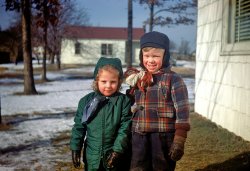
MAY CONTAIN NUTS

Search Shorpy
SHORPY ART

Framed or unframed, desk size to sofa size, printed by us in Arizona and Alabama since 2007. Explore now.
Join and Share
Ad-Free Shorpy
Shorpy is funded by you. Patreon contributors get an ad-free experience.
Learn more.

Recent comments
- Alas, hidden from view
- Exclusive pump
- Details, Details
- What's that building to the left of the tower?
- Coal Barges
- Bromo-Seltzer
- Inner harbor
- The Basin
- What a headache!
- Giant stepladder?
- Baldwin 62303
- Baldwin VO-1000
- Cold
- No expense spared
- Tough Guys
- Lost in Toyland
- And without gloves
- If I were a blindfolded time traveler
- Smoke Consumer Also Cooks
- Oh that stove!
- Possibly still there?
- What?!?
- $100 Reward
- Freeze Frame
- Texas Flyer wanted
- Just a Year Too Soon
- WWII -- Replacing men with women at the railroad crossing.
- Yes, Icing
- You kids drive me nuts!
- NOT An Easy Job
Member Photos
The Shorpy
Print Emporium
Print Emporium
Search Shorpy
Search results -- 30 results per page
- Ocey Snead: 1907
- ... me chills. It is local tradition to visit the grave on Halloween.
Ocey's hair The length of her hair is actually pretty ... Posted by Dave - 05/30/2019 - 9:47am -
![Ocey Snead: 1907 "Mrs. Ocey Snead, in bed, baby in arms," December 1907 or January 1908. 5x7 glass negative, George Grantham Bain Collection. View full size. Ocey, who was found dead in an East Orange, New Jersey, bathtub in November 1909, drugged and emaciated, was at the center of scandalous murder case involving her mentally unbalanced mother and a spinster aunt who starved herself to death while awaiting trial. Along with a third sister they were thought to have conspired to drug and starve Ocey to collect $32,000 in insurance money. Ocey had two children, one of whom died in infancy. (Coverage in the New York Times noted the discovery of small bones in the furnace at a building where Ocey lived -- a Brooklyn tenement dubbed "house of mystery" and "baby farm" by the neighbors.) One part of the mystery is how two photographs of Ocey, very much alive, ended up in Bain News Service collection of glass negatives at the Library of Congress. (The other photo is dated 12-21-07). Are they are family photos obtained in the course of covering the trial of the sisters? Or is there some reason GGB would have photographed Ocey well before she died? (Cue organ music.)
OceyOcey's husband was her first cousin, Fletcher Snead, the son of Mrs. Mary Snead, who was both her aunt and mother-in-law.
The existence of these photos is indeed puzzling. Could it be that Mrs. Snead and her sisters hired a photographer in order to send photos of Ocey and the new baby to Fletcher, then living in Canada? Fletcher insisted his mother and her sisters loved Ocey, but their behavior indicated just the opposite.
More details of this strange case can be found here:
http://www.njhm.com/eastorange1.htm
OceyVery interesting story. Very strange family. Beautiful girl ... just look at that hair!
OceyHaving read the New York Times articles as well as the East Orange link, I still don't understand why her photo would have been taken by a news service two years prior to her death! Does anyone have any ideas? This story, and the story of the "Black Sisters" (any photos of them??) are ripe for further investigations.
[Just because the photo is in the Bain archive doesn't mean the news service took the picture; it could be a family photo. - Dave]
Ocey, RIPAs noted above, you can follow the entire story in news articles at the New York Times archive. I just discovered that amazing site. This is really a very interesting story, too bad for Ocey though. I grew up in Bricktown, New Jersey, so this little story really hits home for me. Thank you.
That pictureCan anyone identify the photo/print on the wall behind her?
For some reason my wife and I are heartached over this story and photos. It would make a good movie from the perspective that her family was indeed evil. Was her long hair an indication of her long isolation?
The "Black Sisters" also are a legend in VirginiaI grew up in Christiansburg, where the "Black Sisters" are said to haunt the middle school. There were mysterious deaths when they ran a woman's college there at the turn of the century. There were always strange occurences at the school. I have seen Virginia Wardlaw's tombstone. Broken in half and lying on the ground, it's inscribed SHE IS NOT DEAD. That always gave me chills. It is local tradition to visit the grave on Halloween.
Ocey's hairThe length of her hair is actually pretty typical for the times, and has nothing to do with how long her family had been keeping her close. Just think about the classic Gibson Girl upsweep for a moment; it takes a lot of hair to create the styles that were in vogue even after famed ballroom dancer Irene Castle started a trend by bobbing her hair short.
Since the length and thickness of a woman's hair was directly linked to perception of her beauty (and was about the only vanity that women were allowed to indulge), most women wore their hair as long as they could grow it. Hair that couldn't be coaxed past one's waist -- or worse, thin hair -- meant resorting to 'rats' and other padding devices to add volume. There was a booming cosmetic trade in thickening solutions and hair growth tonics; many manufacturers sponsored contests for "longest hair" (and often used the photos in their ads).
Women would also keep a "hair receiver" on the vanity, and yes, it's exactly what it sounds like -- when you cleaned out your brush or comb, you put the hair in the receiver so that you could later make false curls, the aforementioned rats, falls, braids, or other things to supplement your 'do. Remember also that jewelry either incorporating or made from a person's hair was exchanged as a personal memento; mourning jewelry of the period often features a lock from the deceased.
Ocey's hair looks to be about knee-length, and quite thick; in other words, a bit longer than average, but hardly extraordinary. Famous beauties of the time had hair that was calf-length, or even longer; some were photographed with their hair loose and dragging the floor behind them. The photos here were probably taken before her mother began really starving her, as that would have caused a great deal of thinning. It says something about how the standards have changed, as my hair is considered quite long, but it's only hip-length. And I'd love for mine to still be as thick as the unfortunate Ocey's, but a bad perm when I was 11 (not my idea, I might add) changed that for good.
Remembering OceyI first read about Ocey in our local library, in 1976, Pittsfield, Mass. The book was called "The Bathtub Murder." All during the reading all I smelled was blood. She has never really left my mind, though I couldn't remember her name. Finally did search for her on Google, something like "bathtub murder NYC 1910" to hopefully find her and sure enough, there were sites devoted to her. I reread the book.
I cannot state loud enough that she needs to be remembered, memorialized, and so I tell her story to all who would listen, as well as sending out links to her story. Yes, a movie in black and white, with actress who looked like her would be excellent, as long as it doesn't go the way of all fact-based movies, and hire actors who cannot fully express the times, the life, and the horror of her tragedy.
(The Gallery, G.G. Bain, Portraits)](https://www.shorpy.com/files/images/02718u.thumbnail.jpg)
- The Black Cat: 1936
- ... a cat alog on your front porch.
(The Gallery, Cats, Halloween, Walker Evans) ... Posted by Dave - 10/31/2016 - 9:49am -
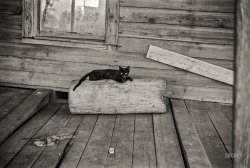
- And a Dog Named Boo: 1936
- ... cell phones. (ha ha)
(The Gallery, Carl Mydans, Dogs, Halloween, Milwaukee) ... Posted by Dave - 10/17/2017 - 12:39pm -
![And a Dog Named Boo: 1936 April 1936. "House at 1629 North Ninth Street, Milwaukee." Or should that be 1313 Mockingbird Lane? Medium format negative by Carl Mydans. View full size.
North Ninth No MoreThis extension of North Ninth no longer exists. The area where the house was is now a large apartment complex.
Store for rentFish? I dont smell no fish.
I think I would remove the fresh fish sign before putting up the for rent sign!
I had to google "Simonizing" just to learn it's a 50-cent word that means polish, as in an auto.
[Simoniz was a brand of car wax. - Dave]
What a deal!Living both above and behind the store!
You've got mailThe door on the right of the residence appears to have a glass mailbox with a letter visible through the glass (it is diagonally placed inside). These were made by some glass makers during the depression era glass craze in the 1930's so one could see at a glance if there was anything inside. I have one made by the Bartlett-Collins Glass Co. (now defunct) in Oklahoma which has an aluminum lid and hanging base although the one pictured appears to be a different kind of metal. I would never hang it outside for obvious reasons, but I did plan to keep my "bills to be paid" in there, and hang it in the kitchen as a reminder and novelty, but never did. I imagine they were not durable enough to catch on. There is also a small clothesline on the top porch with clothespins clipped onto it, so somebody must be home.
SimonizingSimonizing was what people did to their watches when they were coordinating something - before there were cell phones. (ha ha)
(The Gallery, Carl Mydans, Dogs, Halloween, Milwaukee)](https://www.shorpy.com/files/images/SHORPY-8b28653a.thumbnail.jpg)
- Bones: 1938
- ... Blue Period," J.D. Salinger)
(The Gallery, Halloween, Medicine, Philadelphia, Stores & Markets) ... Posted by Dave - 10/31/2013 - 3:51pm -
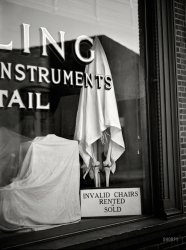
- Mrs. B. Bakes: 1917
- ... so she should wear her cocktail dress and high heels. Halloween was on a Wednesday in 1917, my father was eight years old. Would ... Posted by Dave - 09/13/2011 - 7:57pm -
![Mrs. B. Bakes: 1917 Washington, D.C., circa 1917. "Mrs. Beuchert." Whose psychedelic stove is far out, man. National Photo Company Collection glass negative. View full size.
Old PlumbingWow! I started as a plumber's helper in 1956, and haven't seen one of what we used to call "sidearm" water heaters in many a year. There is a coil of copper tubing in the coal stove that would heat the water, which would very slowly rise into the large riveted tank on the right, providing about thirty gallons of hot water. Gradually both the stove and tank were replaced with gas fired appliances.
Looking upThe stove matches the psychedelic ceiling!
Elaborate Door CloserI never would have thought there would have been a door closer mechanism in a residential building in those days.
A questionWhat is the device with the six holes at the top of the door, right side?
Air Freshener?Is that an automatic air freshener at the top of the door? Looks like something would shoot out every time the door closed. Maybe it was insecticide. A commercial-type door closer also, unusual for a residential kitchen.
What is it?Is anyone old enough to know what the device right of the door closer is?
Granny Found?Looking through the census records, I find two possibilities for the identity of Mrs. B: the first is one Lena Beuchert, a German immigrant born in 1862, making her about 55 at the time this photograph was taken. Her husband William and their son ran a bakery, which may explain these photographs. The second match is also a Lena Beuchert, a widowed German immigrant born about 1851, making her about 66 at the time of this photograph. Which one is it? Perhaps someone with better investigative skills than mine can provide an answer.
High Art NouveauThat beatiful stove would probably sell now for about sixty times what Mrs. B's house was worth.
Early burglar alarmAbove the door, on the right, seems to be some sort of device to, perhaps, alert folks when the door opens. My aunt used to keep little bells on her outside doors just for that purpose. In the old days, of course!
She ain't no Betty FurnessMrs. Beuchert seemed less than enthusiastic about whipping up some vittles and she is also a bit sloppy (flour all over the place and her hand resting in the dough bowl). I love the inventive improvised towel rack made of twisted wire strung out between the stove and the door frame and nobody told her there would be picture-taking so she should wear her cocktail dress and high heels. Halloween was on a Wednesday in 1917, my father was eight years old. Would love to know what he did that year. My imagination is running wild as to what mischief kids got into in 1917.
What is it?Does anyone recognize this hardware device next to the
door closer?
[It's an excellent example of the thing found here. My guess is that's it's some sort of noisemaking alarm. This seems to be a commercial establishment. - Dave]
Novelty KitchenerFound this 1909 ad for a combination coal/gas range made by Novelty Kitchener.
The one in the ad looks fancier. I'm also going to go out on a limb and postulate through my keen detective work that this photo was taken in October 1917.
So peaceful picture...... and exactly these days (10.25.1917) there was October revolution in Russia wich killed the country after all. That's why Russia's history was broken and torn but America's not. That's why I love Shorpy.
Adding to previous commentI mean I look at Shorpy's pictures and I see kind of Russia could be but never been.
The best of both worldsI love that room. I would put down linoleum, braided rugs, paint the walls a soft peach color, add some lace curtains, leave the marvellous sink and table as is, and take the lady shopping for new duds.
(The Gallery, D.C., Kitchens etc., Natl Photo)](https://www.shorpy.com/files/images/31219u.thumbnail.jpg)
- The Old Burying Ground: 1906
- ... like the tattered one in the photo.
(The Gallery, DPC, Halloween, Salem) ... Posted by Dave - 10/28/2011 - 1:57pm -
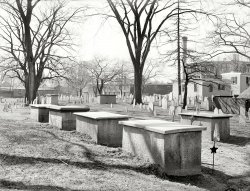
- Sloss City Furnaces: 1906
- ... and enjoying the show.
Sloss Fright Furnace Around Halloween time, Sloss Furnace is converted into a "haunted house." As you are ... Posted by Dave - 07/30/2012 - 4:34pm -
![Sloss City Furnaces: 1906 Birmingham, Alabama, circa 1906. "Sloss City furnaces." Four years later, our site's namesake, Shorpy Higginbotham, would be working for the Sloss-Sheffield Iron Co. at nearby Bessie Mine, helping to supply coal for the furnaces at this steel mill. 8x10 inch glass negative, Detroit Publishing Co. View full size.
Heavy MetalSloss Furnaces is occasionally used as a concert venue. I saw Rage Against the Machine perform there in the late '90s.
No sign of Shorpy's ghost.
Ghost of SlossI grew up in Birmingham and went there several times on school tour groups. The guides always pointed out the hidden gravesite of a small dog behind some hedges near one of the side buildings. Apparently the dog was loved by the furnace workers and lived there. I wonder if it's still there!
The Pittsburgh of the SouthGrowing up in Texas, I was taught that this was one of Birmingham's nicknames. I never really knew if the people of Birmingham ever referred to their city as such.
FascinatingSteam, smoke, water, stacks of ingots, men bending their backs both with work and also hands in pockets as per the older gent standing at the rail carriage. There's a lot going on here all right. Not a day to hang the washing out!
Can anyone explain the process going on here?
Still thereI took the scenic route back to the airport last summer (in part by "lost by GPS") and it was still there. I did not expect it and was surprised to see the furnace right off the road. Looked it over and U turned to check it out again. Tried to imagine what it was like to see it in production.
Wow! Whatta photo!
StackedI wonder what's going on in the lower center. Looks like a fair amount of wood stacked up, and possibly being burned in the large shed. They might be making charcoal, but why would they bother if coal was available?
[Those are metal ingots. Ore goes in, iron comes out. - Dave]
Lazy SusanLove the Southern RR ventilated car, the lazy-susan narrow gauge bridge track, and the link-and-pin couplers on the little engine shoving cars into the plant and the in-house railcars. Very interesting moment in time captured here.
A brief [?] explanationThere are a lot of folks who know more about this than I, but I can give you a simple sketch of what's going on.
The tower just left of the central shed is the charging stack. Note the elevator running up the left side. This is used to haul the ore, limestone and whatever else is needed to the top.
The foreman in charge mixes the ingredients in the correct proportion into the top of the stack. This stuff is heated at high temperature in the blast furnace and when it's all blended and liquefied, the bottom of the stack is opened to allow molten steel to run onto the floor of the large central shed. This molten steel is run down narrow gutters in the floor and turned into molds to cool. These molds full of red hot steel look like little piglets being fed by their mommy. That's where they started calling them "pig iron."
Note the small steam locomotive with its rear facing us to the left below the elevator. Both the engine and the cars down there have link and pin couplers that were outlawed for interstate commerce by about 1900, which indicates this engine and cars may belong to the steel company. It appears they are hauling waste, also called slag, away.
At the far left edge of the photo is a four wheeled railcar with a large pocket on an elevated track. This looks like a "larry car" which was filled with coal and dumped into a coke oven from the top. The oven was sealed shut and the coal was "baked" to create coke, which burns much hotter than coal, which is needed to make steel. I'd say Mr. Shorpy's coal was turned into coke right here in the steel plant. (A single larry car could run atop any number of ovens, which would be off camera here.)
Note in the foreground the narrow gauge plant track on a turntable. This appears to allow the narrow plant track to cross over the wider track at a slight elevation. When the wide tracks are used, the narrow track is turned away as it is here.
Worth a visitThis is now one of the most incredible national monuments in our country. The only one I know similar to it is Gas Works Park in Seattle, and you can't actually explore it. You can walk all over Sloss. Just another example of how much incredible potential Birmingham has.
Mom and Dad and ShorpyAs I child, I lived about three miles from where Shorpy would've lived, Bessie Mines. I live in West Jefferson. Incredible place. My parents met working on Miller Steam Plant.
Iron OnlyOlde Buck basically nailed it. The three ingredients are iron ore, fluxing stone (usually limestone) to draw off impurities, and coke, which adds carbon to the mixture and also burns to superheat the interior.
But, blast furnaces only produce iron. As iron contains many impurities, it’s actually a much weaker metal and more susceptible to stress and fracturing. To make steel, the impurities have to be burned off in a separate facility, or "converter."
In this era, it could be done in a bessemer converter by blowing air into the molten iron. This started a chemical reaction, igniting manganese, then silicon and finally carbon monoxide; took about 20 minutes to burn it all out. Also coming into their own at this time were open hearth furnaces, basically a regenerative furnace, where scrap and molten iron were mixed to create custom blends of steel.
The items in the photo "Stacked" are iron pigs aka "pig iron" – "ingots" are gigantic blocks of partially cooled (just enough so they can be handled) steel that are fed into rolling mills and formed into various shapes such as beams and rail.
Ghost AdventuresI watched an episode of Ghost Adventures where they visited Sloss Furnace. This place really caught my attention and some of the stories that went along with it were pretty crazy.
The Magic CityI, too, grew up in Birmingham in the late '50s and all of the '60s. We heard about "Pittsburgh of the South" in school, of course. It was printed in them Yankee textbooks from up Nawth. But the C-of-C called Birmingham "The Magic City" while I was growing up.
I remember Sloss very, very well, and fondly, too, in a retrospective kind of way. My father worked near Sloss (in a different career field) and we frequently passed Sloss as we travelled over The Viaduct, a raised portion of 1st Avenue North that went right beside Sloss. On some evenings when they would pour out the molten steel huge plumbs of steam would billow forth. These clouds would take on a glow the same bright red-orange color as the molten steel. Traffic would slow briefly along The Viaduct as we would all want to watch the spectacle. There was always an incredible aroma that billowed out along with the steam. It was deep, rich and earthy, somewhere between rotten eggs and burnt coal and wood. When the wind was right, you could smell this aroma even at my parents house in the Roebuck neighborhood, some 8-10 miles from Sloss.
I had to move away from Birmingham in 1969 when My father took a new job. I was so glad to hear they have saved Sloss and turned it into a national monument-- and a performance arts center! I was eager to take the tour when I got back there for my first visit in years back in 2004. Attached is a photo I took then of Sloss today. For anyone wishing to explore Sloss online, may I suggest http://www.slossfurnaces.com/ Thanks, Shorpy, for letting me share some memories with you! -DJQ
Old FurnacesLooking at the way things are laid out, and given the time frame visible here, these are the OLD Sloss Furnaces. This view of the furnaces changed in 1927 when the furnaces were totally rebuilt with modern equipment. At the time of this photo, these furnaces had only been in operation 1899. This picture was taken around the time the new boilers were installed.
Muse of Fire: Shakespeare at Sloss I've enjoyed working with Muse of Fire for the past several spring seasons as we perform Shakespeare under that shed in the center of the Shorpy photo. In the fall we stage select Shakespeare scenes in various spots along the walking trail around the Sloss facilities. There's nothing like having trains running by 100 yards from the stage, blowing their whistles for all they're worth.
Having rehearsed late into the night several times, I have to say that it's easy to believe that Sloss is as haunted a place as I've ever been (especially deep in the back near the old brick ovens).
Thanks, Dave, for posting this great photo of a cherished landmark in my hometown. I think of Shorpy Higginbotham at every rehearsal and performance, and I wonder if he's watching us and enjoying the show.
Sloss Fright FurnaceAround Halloween time, Sloss Furnace is converted into a "haunted house." As you are walked through the place, you are confronted by ghouls, ghosts of angry steel workers, zombies, and psychos. My brother & I went there this past October.
(The Gallery, Birmingham, DPC, Factories, Railroads)](https://www.shorpy.com/files/images/4a13398a.thumbnail.jpg)
- The Visitor: 1928
- ... his shower and listen for the reaction.
(The Gallery, Halloween, Medicine, Natl Photo) ... Posted by Dave - 10/30/2009 - 5:17am -
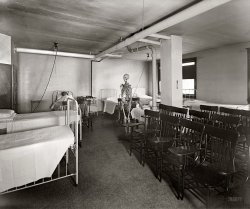
- Bathing Beauty Parade: 1927
- ... one of the bathing beauties looks like she could be in a Halloween Parade.
Bottom Picture, bottom row 5th from the left.
[ Is ... Posted by Dave - 10/30/2014 - 11:39am -
![Bathing Beauty Parade: 1927 "Long Beach, California, Bathing Beauty Parade -- 1927." Panorama by Weaver, Los Angeles, rearranged into two tiers of Jazz Age pulchritude. View full size.
Sweet 16Miss Smith was born in 1911 in Lansing, Michigan the daughter of Thomas Jefferson 1870-1948 and English born Ada Evans 1876-?, (married August 1st 1894, Flint).
I can find her in the 1920 census in Lansing and in 1930 in Glendale CA, but after that I am not sure, there is a 29 year old Ada L Green married to a James A Green living in Dearborn MI working as a waitress on the 1940 census
I hope someone (if they really want to) can do a bit better detective work than me.
Who knewThat Vampira was ever in a beauty contest!
Betty Boop?The young lass, perfectly placed in the center of the middle row in the top panel, could have been the model for Betty Boop -- who made her appearance a few years later.
What Beauty!That should have been a question mark since one of the bathing beauties looks like she could be in a Halloween Parade.
Bottom Picture, bottom row 5th from the left.
[Is that a challenge to the colorists amongst us Catherine? - baxado]
To Bob or Not to Bob?It looks like more aspiring bathing beauties were inspired by Mary Pickford than Louise Brooks in the hairstyle department!
[Marceled moreso. -Dave]
no chair climbing for me, thanksThe girl in the back row, straight up from the "A" in "BEAUTY" looks like she just couldn't get situated on her chair in time. But posed gallantly nonetheless.
My pick of the bunch.....top pane, bottom row, six in from the left.
She just looks like a fun happy young lady. All natural. Just love her hand position.
Miss Glendale, 1927Otherwise known as Ada Levinia Smith, as per an article dated August 27, 1927 in the San Luis Obispo Daily Telegram and the Sept. 15, 1927, Torrance Herald, the latter of which is actually online and oddly ties this set of shots in with all the old California car shots we've seen of late on Shorpy.
[Click to enlarge. -tterrace]
Oh! One more thing...Ada Smith was 19 in the 1940 census, so you can probably do the math here.
[She was 6 in 1927??? -tterrace]
Whoops! I meant 1930. I tried to find her in 1940, but she most likely married her surname away (not that 'Smith' is a fun name to track people with), though her parents were still in Glendale at that point.
IncongruityBathing suits and high-heels.
Never could figure that combination.
Fun with TextilesNot that 1920s swimwear is my area of expertise or anything, but I was surprised to see such variety in their swimming suits! There are a lot of great patterns there--and it's definitely one time when it would have been fun to see what they looked like in color.
Deja VuAnother reminder of how bathing suits evolved from the styles of 1900-1910 to 1927, though some 'retro' models can be seen. Motley Lovelies.
Photo bombs...even back then!Someone was getting an eyeful in the background!
Playing Woulda, Shoulda, CouldaI turn this panorama of pulchritude into a delightful desktop image and have enjoyed playing my game and being amazed at the varying degrees of beauty shown here from the dainty miss to bored housewife to party girl to genuine beauties in any century to a few ladies I would ask to marry me if that were possible.
(The Gallery, Los Angeles, Pretty Girls)](https://www.shorpy.com/files/images/SHORPY-06701u3.thumbnail.jpg)
- City of Cleveland: 1910
- ...
Ghost Ship One of the ships managed by one of the Halloween house owners.
Largest Side-Wheeler in the World Popular ... Posted by Dave - 08/14/2012 - 4:26pm -
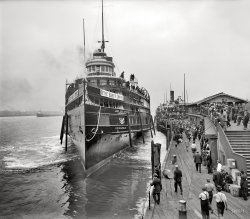
- Pillars of the Community: 1939
- ... in it appears to have a face. Looks like a papier mache halloween mask or a scary doll.
[I'm going with your first guess, but I ... is either a wasp or hornets nest. More scary to me than a Halloween mask or scary doll.
[Here's a closer look. -tterrace]
... Posted by Dave - 07/16/2013 - 6:26pm -
![Pillars of the Community: 1939 1939. "Wade House. Huntsville vicinity, Madison County, Alabama." 8x10 inch acetate negative by Frances Benjamin Johnston. View full size.
Demolished 1952More on the history of this house can be found starting on page 38 of this edition of Historic Huntsville Quarterly.
EEEK!There is something hanging out of the second story window on the end by the chimney. At first I thought it was a rag stuffed into a missing pane, but when I zoomed in it appears to have a face. Looks like a papier mache halloween mask or a scary doll.
[I'm going with your first guess, but I think it's a pillow. -tterrace]
Engineer Comment DesiredThe evenly spaced voids in the brick work makes me think that is where scaffolding supports were during construction. Would love some construction insight on that.
Brick vents The evenly spaced holes are air vents to reduce moisture between the brick facia and the wooden structure. At times weep vents are at the bottom of walls and floor separation. These vents also reduce air pressure during higher winds that can actually cause the wall to "blow out".
EEEK! My guess is a wasp nest....
Facade?The gaps in the brickwork might have anchored a facade, possibly lath to support stucco.
In working on our brick and block house, we find many little blocks of wood that were embedded in the brick while it was being laid, to provide anchorage for lath and moldings. Mostly in the interior, but some on the exterior.
Putlog HolesI think that Downer is correct - the small dark holes in the brickwork of both stories are left over from the insertion of wooden scaffolding to construct the brick walls. These holes are aptly known as "putlog holes," because that is where the builders put the "logs." Putlog holes were meant to be filled with bricks once the walls were finished, but often enough they were not. This occured in traditional brick construction both in Europe and in the United States.
Too poor to plaster, too proud to whitewash.It seems the holes correspond to the placement of iron hinges for blinds and floor joists. I'd say it's an unfinished project judging by the lack of plaster.
Antebellum WYSIWYG architecture?Seems to be a lot of front for not so much house.
A little insight.Upon reading the article that mechmike talked about we can see that the holes likely held something decorative because when the article was written the bricks were still discolored from being covered. Here is a quote from the article below.
"a series of holes and discoloration on the front brick
wall strongly support the removal of a more formal treatment, including simple
pilasters at the corners of the facade. Photograph by Alex Bush fo r HABS, 1935"
They holes are also definitely not air vents between the brick facia and the wooden structure like Poikaa suggested since this structure is solid brick with no wooden structure behind them. Here is a quote from the article about that.
"It was a massive structure of solid
brick, two tall stories above a raised basement".
House HistoryMy grandmother's grandmother (Maggie Wade)grew up in this house... it was built by my great-great-great-great-grandfather David Wade in 1814 after he came to Madison County from Bedford Co. VA. My grandmother remembers going there around 1925, she said there were turkeys and chickens wandering around the kitchen. It was located on Bob Wade Ln off the Parkway in North Huntsville, there a brick ranch house there now but the smokehouse still remains. After the house was demolished the bricks went on to be reused in the Lary House on Echols Avenue (recently demolished by the Propst Family) as well as the Spencer house next door to Leroy Pope's house on Echols Avenue in Huntsville.
Second story windowI believe the "thing" on the second story window is either a wasp or hornets nest. More scary to me than a Halloween mask or scary doll.
[Here's a closer look. -tterrace]
Unfinished dreams...Brick columns were not as unusual as we may think; except, they would have been finished with a layer of stucco in most cases - not all. The holes present on the brick façade would have been used to insert the pegs of a lath system designed to support some other formal system: it could have been a series of pilaster sided by bays of stucco, for instance. Whatever it was (but it must've been something), it seems to never have been installed, however - since there are no traces of any of it... anywhere. The stoop at the front door was either never finished, or removed for some unknown reason. It all seems to add up once one reads the article present in the Huntsville History Collection (link available in another comment). It clearly states that Mr. Wade seems to have run into some kind of financial predicament before he could finish the house. In spite of the house having been started in ca. 1820 (land purchased in 1817), by 1857 (the year he drafted his will) the house was still unfinished; it is clear that is was occupied by his heirs, though. This could be the simple case of a dream left unfinished – that's all.
(The Gallery, F.B. Johnston)](https://www.shorpy.com/files/images/SHORPY_00104a.thumbnail.jpg)
- Spook Hill: 1940
- ... well worth a visit.
(The Gallery, Arthur Rothstein, Halloween, Mining) ... Posted by Dave - 01/28/2018 - 6:35pm -
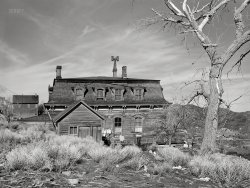
- Dark Garden: 1938
- ... by Paul Vanderbilt. View full size.
(The Gallery, Halloween) ... Posted by Dave - 10/30/2017 - 9:51am -
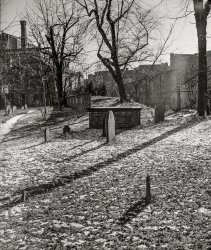
- Pumpkins Aplenty: 1938
- ... instead.
(The Gallery, Agriculture, Dorothea Lange, Halloween) ... Posted by Dave - 10/31/2019 - 9:48am -
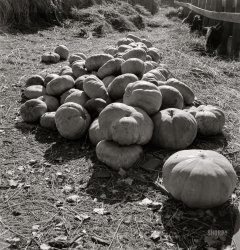
- Flying A: 1953
- ... At first I thought he had cat eyes (and just in time for Halloween).
Behind Creepy Man is a '53 DeSoto.
Bug Deflector The ... Posted by Dave - 10/20/2015 - 7:56pm -
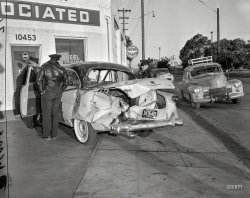
- Labatut: 1938
- ... When I was in seventh grade, I made a poster for a Halloween party. The house in it looked eerily like this.
Twilight Looks ... Posted by Dave - 07/22/2012 - 4:42pm -
![Labatut: 1938 Pointe Coupee Parish, Louisiana, 1938. "Labatut. New Roads vicinity, built by Don Evariste de Barra, Spanish grandee, 1800. His descendants, the Labatut and Pugh families, still living here." Photo by Frances Benjamin Johnston. View full size.
It's still thereAnd you can see it here.
Spooky!When I was in seventh grade, I made a poster for a Halloween party. The house in it looked eerily like this.
TwilightLooks like a good place for vampires to hang out during the day!
SomewhereThe dog, the chicken, the orphan shoe. I know they're there somewhere, I just can't find them.
Jedi HouseWhen 138 years old look this good we will not!
LabatutI've looked all over the internet for a translation of Labatut ... as far as I can tell, it means "hidden away." Can someone let me know if I am right? I am so in love with FBJ's work, I can't wait to load Shorpy every day to see if there is something new from her archives!
[It's a family name. According to the caption, the Labatuts are descendants of Don Evariste. - Dave]
Obviously a loving restoration, except....couldn't Tom get some help whitewashing that picket fence after Aunt Polly told him to do it?
Beyond that, the house (in 1938) looked abandoned, what with a few of the windows being broken. Quite a beauty now, however.
Right on the leveeAfter picking through Google maps and street view, I noticed that the house is right across the road from the Mississippi River levee. I wonder how many floods this house has endured over the past 210 years.
Hail yes!Try and imagine the racket when a hailstorm collided with the galvanized roofing on the original home!
If the walls could talkThank you Minot for the additional info on Labatuts. Really interesting then and now. This house has seen alot of history! It must've been built well. Any ghost stories? Looks worthy of being registered as a historical site.
Running water, in the rainy seasonTo the right of the house is the foundation formerly holding a wooden cistern. These were common South Louisiana plantation houses of that era; they collected rainwater from the roof. (Rainwater was preferred to water from the muddy Mississippi which had to be let settle.) Most of the old cisterns are long gone; an exception is the San Francisco Plantation between Baton Rouge and New Orleans which has a beautiful pair of cisterns rebuilt in the original style.
I'm so happythat the house is still there and is being restored. Thanks Minot, for the info.
Family TiesI'm a Labatut. My grandfather grew up in this house. I haven't seen it in a long time. Good to see it restored.
(The Gallery, F.B. Johnston)](https://www.shorpy.com/files/images/01476u.thumbnail.jpg)
- American Gothic: 1905
- ... interesting!
1313 Mockingbird Lane With or without Halloween decorations this would be the scariest house on any block.
... Posted by Dave - 08/03/2012 - 4:06pm -
![American Gothic: 1905 Detroit, Michigan, circa 1905. "Residence of W.C. McMillan." 8x10 inch dry plate glass negative, Detroit Publishing Company. View full size.
The AddamsesCharles Addams supposedly modeled the Addams Family Home after College Hall at The University of Pennsylvania.
This one was tricky to findThe house was at the corner of East Jefferson and Russell, says the Detroit News ("the former home of U.S. Senator James McMillan, which had been built during the 1870's.")
It eventually became the home of the University Club. In 1931 another University Club, now a YWCA, was built on the site.
View Larger Map
It's a Mickey Mouse MomentIsn't that the Applegate Mansion? (Think of F.W. Dixon)
The Success/Failure of Black & WhiteWhat makes this house spooky - the epithet used by so many posters on this topic is the fact that it is in black & white. The look of the house is dark & foreboding and even the ivy can't soften it.
Now imagine this house in colour. Dark red brick with the green ivy in contrast. The areas around the windows in either sandstone or terra cotta. The Victorians and Edwardians loved colour and paint technology was giving them an affordable rainbow of shades. Trim, like the railings around the porch in one colour, the sashes for the windows in a different one. The big oak door would be in contrast to the stone around it, and the whole thing would be topped with a slate roof. Suddenly it ceases to be sinister and becomes just another Victorian home, which if it was kept up would be no more sinister than a lot of newer buildings.
Fire BreathingI wonder if Spot still lives under the stairs.
Don't go in the tower, you fool!Ah, but who--or what--lives in the upper tower room?
Erie guyWilliam (W.C.) McMillan, eldest son of three-term Republican U.S. Senator James McMillan of Michigan, was then the president and general manager of the Detroit & Cleveland Navigation Company, which provided daily service during the navigation season between Buffalo and Detroit, and Cleveland and Detroit. At the time of his death two years later ("at home" in February 1907), he was also president of several iron or steel companies and shipbuilding companies, and one of three co-owners of the Detroit Free Press. In 1902 he declined to be a candidate for election to the Senate vacancy created by his father's death.
Update: A Marshall, Michigan, newspaper's report of his death gave his address as 452 Jefferson Ave. Based on turn-of-the-century economic segregation patterns, it's probably East, not West, Jefferson. 452 E. Jefferson (under the pre-1920 building numbering system) would be on the north side of the corner of E. Jefferson and Rivard St. (near the Palm Apartment site); 452 W. Jefferson would be between 10th Street and Rosa Parks Blvd, where a truck terminal is now located.
The Adams FamilyRight?
[You're close. It's "Addams." - Dave]
Electricity?Did Detroit have power poles in 1905?
[Yes. And telephone poles, too. - Dave]
Dare you to go inGosh, when I was a kid there were a bunch of these vintage places about town all deserted and creepy. Naturally we all had to find a way in and explore. A few of these adventures ended at the police station but as we were not vandals we got off with a good scary official tongue lashing.
Some places were left with everything still inside as if the people just one day vanished, never to return. It sure was interesting!
1313 Mockingbird LaneWith or without Halloween decorations this would be the scariest house on any block.
ChillingI can't get enough of gothic architecture. So eloquent and emotional while still wholly austere.
McMillan & DadWilliam C. McMillan was a son of of Michigan Sen. James McMillan, who was chairman of the Senate Park Improvement Commission of D.C., better known as the McMillan Commission. Sen. McMillan died in 1902, two years after the commission was formed.
The "McMillan Plan" resulted in removal of many of the slums that surrounded the Capitol, replacing them with new monuments and government buildings that now form D.C.'s "monumental core," as well and the National Mall and Union Station.
As for W.C. McMillan himself, he was general manager of the Detroit and Cleveland Navigation Co.
HousesI am referring to the 7th picture in the article that Cnik70 linked to in the Detroit News ("Where Detroit's elite met to eat," August 9, 1996) http://apps.detnews.com/apps/history/index.php?id=155 - the one labeled "The James McMillan Mansion on Jefferson was an early home of the University Club." I am not referring to the picture he posted, which shows the same location today. The picture in the Detroit News shows a house that belonged to James McMillan, not to his son William C. McMillan. At first I thought that it was the same house, passed from father to son, but looking at the architecture closely, I say it's not. If you can figure out how to post that picture here (I'm sorry I can't), the others may see what I mean. Thanks!
Housing styleFYI, there is nothing Gothic about this house. It is an Italianate villa, which is a type of Romanesque revival popular in the middle to late Victorian period. Notice the semi-circular arches in the windows, and the tall square tower, typical of the style. Gothic arches are pointed, and the Gothic revival would have some sort of spire, if anything, not a tower like this. The more extreme Gothic revival buildings even have 'superfluous excrescences' [I love that term, not my creation.] like gargoyles spires, cornices, etc., to dress it up. The Romanesque revival is, overall, simpler and cleaner, with more straight lines. The lines in Gothic revival tend to be more broken up.
The tower is where you would lock up an insane or mentally handicapped relative, or perhaps a wayward, unmarried female relative who had managed to get herself pregnant.
(The Gallery, Detroit Photos, DPC)](https://www.shorpy.com/files/images/4a12864a.thumbnail.jpg)
- Super Fly: 1972
- ... before he spiked his hair. I wore an outfit like that to a Halloween party a few years ago and it was a big hit, but now you might see it ... Posted by tterrace - 06/20/2015 - 7:46pm -
![Super Fly: 1972 Some may find it fitting that this photo of me was taken at the San Francisco Zoo. I remember having striped pants in the 70s, but this total ensemble comes as a surprise, since I'd never seen this photo until a few days ago. It turned up in a box of forgotten slides at my friend's house. I attribute my expression to having just spotted him aiming his camera at me. For my part, I'm clutching my first movie camera, a Super-8 GAF job with an 8-1 zoom lens. View full size.
Fashion Commenttterrace...I like your choice in " Wallpaper" trousers. In the late 60's and early 70's I worked in a computer center and, usually, wore very conservative clothes. One day a workmate of mine said, " You know? If you ever die on the job they won't have to take you home to get a change of clothes. They can just bury you in what you are wearing". I decided to change my wardrobe and ended up buying double-knit, bellbottom trousers with a large square tartan pattern, a shirt that you could see a half mile away, and a tie with a psycho-funky-delic pattern. The first day I wore my new clothes into work the same person took one look at me and said, " Sorry to see your curtains died" and walked away. That was the last time I ever even considered what people thought of my attire.
Is this a great country or what?America, a country that reduced speed limits to 55 mph to save enough petroleum to make double knit polyester suits! I hope none of my photos show up on Shorpy.
[Not sure those trousers are; I never intentionally got polyester double-knit anything. The blazer I remember having had for years and years at this point. Shirt's probably a standard cotton-polyester blend. n.b. This is not intended as an apologia for my past fashion choices. -tterrace]
Always in styleThe classic blue blazer never goes out of fashion.
GAF, ancient history in moviesUsed ten of those GAF Super-8 cameras to teach film-making to my classes in media studies at about the time you were photographed.Not very durable cameras, most expired within three years.
To be replaced with another ten; students were never careful with hardware it seems.Had more success teaching black and white photography with Pentax SLR's!
Fashions changeDon't worry, I've seen worse. Including what my parents put me into when I was a kid (late baby boomer myself) and what they were wearing at the time. And thankfully they even never subscribed to the psychedelic craze.
Apart from that, it would still be correct from a pattern point of view today (plain and plaid or plaid and plain).
What always gets me are those gun license grade shirt collars.
As the guys say, nothing can disfigure a handsome guy! ;-)
[Edit: One "b" too much in "boomer"]
Nothing to be embarrassed aboutConsidering the styles of the time you are dressed quite nicely. That outfit wouldn't be embarrassing to wear today.
Well put-togetherThe eccentricities of the 70s look quite mild these days, don't they?
And that haircut!Forgive us our past tresses.
Thanks for your self-deprecation commentBack then, the rest of us looked like that too!
Nice tterrace!The 70's were kind of sketchy for fashion but you nailed the rock star look. My being ~10 years younger left me under my parents influence which made my portraits from that decade sort of buryable. Ugh.
Considering the possibilitiesyour fashion came out pretty well. I've seen many photos where the guys are wearing leisure suits, or Nehru jackets. This is one era where the men's fashion was worse than what the women wore.
"Beaming" tterraceYou look like a young Leonard Nimoy in this photo.
StripesOkay, gotta say the trousers are a little hard to take... BUT not as bad as mine: gray and red herringbone polyester flares, topped with a dark blue double-knit polyester blazer/sports jacket. Said jacket was fully capable of standing up on its own, it was about 1/4" thick. Like wearing a suit of blue foam rubber. "Draping " the figure? Not hardly.
"You got the look"Was that a Vidal Sassoon commercial? You look like a young Sid Vicious before he spiked his hair. I wore an outfit like that to a Halloween party a few years ago and it was a big hit, but now you might see it on the streets of Manhattan at any given moment!
PantsI had some red, white, and blue vertically striped pants in the mid-70s. My Mom gave them to my wealthy, but cheap, Uncle. He still wears them occasionally to this day at age 80+!
I feel your painI was in elementary school in the early 80s. My big brother is 6 years older than me, and yes, I was forced to wear his hand-me-downs. While everyone else was wearing current fashions and dressing like Billy Idol and Cyndi Lauper, I was the lost member of the Partridge Family. Paisley shirts with big collars, bell-bottoms and Hush Puppies.
AnimalIf I didn't know better, looks like a spitting image of Eric Burdon of The Animals.
(ShorpyBlog, Member Gallery, tterrapix)](https://www.shorpy.com/files/images/paul_sf_zoo_doug_may1972_adj.thumbnail.jpg)
- Thanksgiving Maskers: 1911
- November 1911. Before Halloween came into its own as a holiday in this country, there was ... five-story apartment houses. This was like a holdover from Halloween.
And the old folks say.... I just wonder how many really old ... Posted by Dave - 12/10/2007 - 6:24pm -
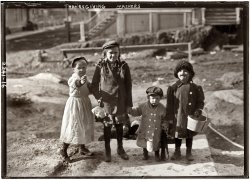
- Birds of a Feather: 1920
- ... if 92 years hence someone saw you in a photo made up for a Halloween party and thought, "My God! Did people really go around like that ... Posted by Dave - 08/29/2012 - 2:10pm -
![Birds of a Feather: 1920 Washington circa 1920s. "Mrs. Gaillard." From a Harris & Ewing portrait series depicting society types in historical and theatrical costumes. View full size.
They're in costume, folksLike it says in the caption. They're deliberately dressed and made up outlandishly - in this case, like showgirls of a somewhat earlier era. Imagine if 92 years hence someone saw you in a photo made up for a Halloween party and thought, "My God! Did people really go around like that then?!?!"
As alwaysAs always, with shots like these from that era, I see Tony Curtis (as in Some like It Hot).
He's second from the right in this one.
And I hope someone showed the little redhead on the left how to avoid her nose with a lipstick!
It's not nice but -The first thing that came to mind was Tony Curtis and Jack Lemmon dressed as women in Some Like It Hot. Hope that's not too cruel.
[It's well-nigh inevitable. - tterrace]
Get Max Factor here fast!Not exactly "dream girls", this quartet of grotesque gargoyles, unless you dream of close-ups of bizarre clowns coming at you. In the l930's and 40's, the major "make up" artist in Hollywood was Max Factor who enhanced the beauty of all the big stars of the day. He even had his own "Max Factor" museum which has since been included in the "Hollywood Museum" and I believe his former line of retail cosmetics is no longer sold.
UnfortunateIt's too bad that these young ladies only have this 92 yr. old photo to show the world what they looked like in their youth. A bad combination of too much makeup, blurry focus, and mold on the glass plate doesn't do them any favors! Bet they looked considerably nicer with simple makeup and a better portrait.
Mona Blodgett GaillardThe first chorine on the left appears to be Mona Blodgett Gaillard (b. 1900), who married Capt. David St. Pierre Gaillard in Washington on November 7, 1921. This suggests that the photo's date is a little later, unless one of the older ladies on the right is her mother-in-law Katherine David Gaillard (1866-1937), widow of Lt. Colonel David DuBose Gaillard (1859-1913), director of engineering on the Culebra Cut in the Panama Canal. The LOC has two 1919 photos of Miss Blodgett, then a Washington debutante. As a wedding gift, her mother, Mrs. Delos Blodgett (Daisy), a wealthy Washington widow, built her "The Rocks," in the upscale suburb of Crestwood.
Mona GaillardHer husband, Col. David St. Pierre Gaillard, died in 1982 at the age of 92. Mona passed in 1990, three months shy of her 90th birthday. They lost a son, David St. Pierre Gaillard, Jr. in 1951 (Korean War?).
Capt. & Mrs. GaillardIt appears from their few surviving LOC photos that the Gaillards enjoyed fancy dress parties or events. Here's another portrait of them from the early 1920s, with no makeup malfunctions. Another, very damaged negative recorded their appearance in Revolutionary War costumes.
Poorly focusedThe Focus is rather soft on this one, not nearly soft enough to help however.
Be nice!You can't judge the past by the standard of today. Yes, their makeup look strange to us. Look beneath it. Those ladies are lovely. I mean, as in, Hubba-hubba!
(The Gallery, Harris + Ewing, Portraits)](https://www.shorpy.com/files/images/SHORPY_18447a.thumbnail.jpg)
- El Cheese Ritz: 1939
- ... have been very interesting at their house, not just on Halloween.
No no my dear You put the Lime in the Coconut, then you ... Posted by Dave - 10/24/2012 - 5:57pm -
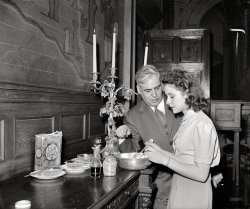
- Shining Path: 1901
- ...
Boo! An appropriate photo to post the day before Halloween. "Walk toward the light."
Be cautious over the next couple of ... Posted by Dave - 07/21/2012 - 9:39am -
![Shining Path: 1901 Originally posted 10/30/2010 - 10:06pm. Our first visit to The Firs.
New Baltimore, Michigan, circa 1901. "The Firs. Under the firs." 8x10 inch dry plate glass negative, Detroit Publishing Company. View full size.
Wonder where this was shot.I wonder where this was shot. I grew up in New Baltimore and have family going back over a hundred years there. Nearly all of the old woods are gone now. I wonder if these ladies were relatives. It would be nice to think so.
[The Firs was the home of the Hatheway family. There was a large house and a barn. The New Baltimore Historical Society puts it at the corner of Washington and Cemetery roads. - Dave]
In hidingI didn't even notice the ladies at first! Sppppppooooooooky.
Scary winnerThis is probably the scariest picture I have seen yet on Shorpy!
Don't go toward the Light!You're not trapping me in your haunted parallel dimension, ghost women!
The BirdsThis looks like it could be a scene from a Hitchcock movie.
Boo!An appropriate photo to post the day before Halloween. "Walk toward the light."
Be cautious over the next couple of weeks!The face of the woman on the far right suggests that she recently viewed the "Ring" film clip. It's a good thing televisions weren't around back then, or she might be receiving an unwanted visit from an entity crawling out of a well.
Ooo, ooooo, witchy womenWhen shall we three meet again?
In thunder, lightning, or in rain?
(I say, could either of you lovelies spare a little eye of newt?)
I can just imagine it.After the fourth or fifth take, the Photographer smashing his Camera, busting the Tripod over his knee, walking off muttering something about "standing still just for three lousy seconds".
(The Gallery, DPC)](https://www.shorpy.com/files/images/4a20404a.thumbnail.jpg)
- The New Bohemians: 1922
- ... it seriously.
Dress up Wow, it must have been Halloween every day when with those two. But I do remember going to one or two ... Posted by Dave - 08/19/2012 - 5:08pm -
![The New Bohemians: 1922 January 10, 1922. New York. "McRay and Baroness v. Freytag." Claude McKay, Jamaican writer and a figure in the Harlem Renaissance, and avant-garde artist-poet Elsa von Freytag-Loringhoven, the "dadaist baroness" of Greenwich Village. 5x7 glass negative, George Grantham Bain Collection. View full size.
I would definitely Watch the movie made about the baroness. Her reputation is that she would make a "Wild Child" look like a tame dame.
DefinitionMcKay's face in this picture belongs in the dictionary as the visual definition of "Bemused".
It's too bad the elites didn't show the same expression to the Dada movement ... instead of taking it seriously.
Dress upWow, it must have been Halloween every day when with those two. But I do remember going to one or two similarly outfitted Southern California love-ins myself, back about 1970. Actually I don't remember too much ELSE about the '70s. And I'm suddenly getting the munchies.
The baronessShe had a bizarre and tragic life:
http://mysite.ncnetwork.net/zzyzlane/write/essay/baroness.html
Dada focusThis doesn't look like lens-smearing blurriness, but rather the use of tilt-plane selective focus.
Dada, I'll say!This is so silly I can't believe it. Yet I find the focus interesting. Do you think smearing the lens with petroleum jelly was popular in those days? I don't, but it would be a Dada thing to do.
SoIs it McRay or McKay?
[McKay. - Dave]
(The Gallery, G.G. Bain, NYC)](https://www.shorpy.com/files/images/33941u.thumbnail.jpg)
- The Jungle Trail: 1910
- ... left by the decaying host.... Hmmm, sounds like a good Halloween story!
Keebler tree Now I know where the elves bake all those ... Posted by Dave - 07/29/2012 - 10:13am -
![The Jungle Trail: 1910 Continuing our Sunshine State sojourn circa 1910. "The jungle trail, Palm Beach, Florida." 8x10 inch glass negative, Detroit Publishing Company. View full size.
Old-school E-ticket ride"And now, the most dangerous part of our journey- the return to civilization and those Florida railways."
A star in the jungleHe really looks like Paul Newman.
Steam bathCan you say "overdressed"?
[Florida was a winter resort, so maybe not. - Dave]
The Palm Beach AfromobileAlthough a decidedly un-PC term by today's standards, these Palm Beach wicker chariots, almost always powered by African-Americans, were widely called "Afromobiles" as a humorous twist on the newfangled term "automobile."
These folks are riding under the limbs of a local oddity known as the Florida strangler fig tree (Ficus aurea), which begins life in another tree until it strangles it. The fig then thrives on the nutrients left by the decaying host.... Hmmm, sounds like a good Halloween story!
Keebler treeNow I know where the elves bake all those delicious treats.
Tis the SeasonMost guests arrive in Palm around New Year's Day. The season ended and the resorts closed shortly after the big St. Patrick's Day Ball.
They were likely guests at the Hotel Royal Poinciana coming back from or heading to Alligator Joe's- a popular destination at the end of the Jungle Trail.
https://www.shorpy.com/node/7748
Looking CloselyDo I see Toto way back on the path?
(The Gallery, DPC, Florida, Travel & Vacation)](https://www.shorpy.com/files/images/4a24126a.thumbnail.jpg)
- Meat Wagon: 1926
- ... souse and scrapple?
Spooky! How appropriate for Halloween to see a ghost in the window.
Herman! Fred Gwynne - the early ... Posted by Dave - 09/04/2012 - 9:38pm -
![Meat Wagon: 1926 Washington, D.C. "Semmes Motor Co. -- Krogmann & Sons truck, 1926." National Photo Company Collection glass negative. View full size.
Star on the wallAnyone know if the (iron?) star on the wall serves any function? It might be just decoration, but I'm guessing it is a decorative dressing for a bolt through the wall.
[Veteran Shorpyites will recognize that bit of hardware as a turnbuckle anchor, or "turnbuckle star." - Dave]
Poor guyYears of sausage delivery seem to have taken their toll.
A complete meal.He's frustrated because he can't find the egg truck or the potato truck.
I wonderDoes he carry souse and scrapple?
Spooky!How appropriate for Halloween to see a ghost in the window.
Herman!Fred Gwynne - the early years.
"Get some pork on your fork"We had a catchy TV advertising jingle Down Here (Australia) back in the 1970's which always sounded just a little bit risque. It would look pretty cool splashed across the side of that van. Far cooler than "The Best by Test"!
"Less Fatty in the Patty"was the slogan for Jesse Jones' sausage down here in the Tar Heel state. Didn't work for link sausage.
(The Gallery, Cars, Trucks, Buses, D.C., Natl Photo)](https://www.shorpy.com/files/images/32449u.thumbnail.jpg)
- Exhibit X: 1922
- ... open.
Creepy, but just you wait Cranking up for the Halloween show perhaps?
Pretty good start I'd say.
Feelthy! I'm always ... Posted by Dave - 09/13/2011 - 11:18pm -
![Exhibit X: 1922 Washington, D.C., 1922. "Social Hygiene Society exhibit." A peek inside reveals the period-appropriate use of scary dolls and mannequins in a variety of cryptic tableaux. National Photo Company Collection glass negative. View full size.
The burning questionWhat exactly is "Social Hygiene"? It has overtones of a group shower.
[Speaking of burning. Social hygiene is how you avoid social diseases. - Dave]
"Speaking of burning."That occurred to me.
"For free distribution"I wonder how many people helped themselves to a nice glass paperweight.
Euphem-topiaI love the way they tried to communicate important information while being extremely coy and delicate about it. Couldn't the common cold be called a "social disease"? I daresay their contemporaries must have been almost as befuddled as we are today about the message.
I think my first experience with this was when I was 15, finding a 1961 National Geographic on a recycling pile. There was an ad in there for a pharmaceutical company, who boasted of working to find a cure for "the type of cancer most prevalent in women." Come on, was the word "breast" really that taboo? Apparently so.
I guess it was around the same time (mid-'80s) that Oprah pretty much singlehandedly made it OK to talk about some of these things in public. At least, that's how I remember it.
Come to think of it, I'm rather bemused at how the exhibits implied that bathing and kitchen sanitation have anything to do with reducing the spread of STDs.
PioneerI think it was Betty Ford that brought substance abuse and breast cancer out into the open.
Creepy, but just you waitCranking up for the Halloween show perhaps?
Pretty good start I'd say.
Feelthy!I'm always amazed how dirty everything looks in these old photos. For example, where the floor meets the baseboard, and all the woodwork in general. Is it really that dirty, or is this an issue with the photos?
Is this the weirdest Shorpy pick ever?Let's say you were rummaging through a box of old photos in the attic at your grandmother's. You find this photo - labeled on the back, even.
How in heaven or hell's name could you tell what was going on in the photo? Who are these matrons, sitting in an office with mannequins dressed as Great War soldiers in the windows next to them, with grown men staring in the windows, and in the far right of the photo, a bunch of baby dolls with strange masks over their heads? Oh, with potted palms and free literature, too?
It's like a still from "Un Chien Andalou."
For every ten shots of buildings on city corners, we get one image like this. It helps to remind us how fleeting are our fashions, our politics, and our concept of what is "normal". Thank you for both.
Gotta love that progressive era"Social hygiene" was one of the reform movements within the larger progressive movement of the period. It basically aimed to end prostitution and venereal (at the time referred to as "social") diseases. Another progressive program from that period was eugenics to breed healthier, happier people. It was generally a pretty creepy period.
(The Gallery, D.C., Education, Schools, Natl Photo)](https://www.shorpy.com/files/images/23671u.thumbnail.jpg)
- Tulare: 1940
- ... are playing? Also, the black cat--I first thought it was a Halloween dance until I saw the date. Maybe the group was an early prototype of ... Posted by Dave - 02/06/2008 - 3:53am -
![Tulare: 1940 March 1940. Visalia, California. Band playing a Saturday night dance at the Farm Security Administration's Tulare migrant camp. View full size. Medium format safety negative by Arthur Rothstein for the Farm Security Administration.
The BandWonder what song they are playing? Also, the black cat--I first thought it was a Halloween dance until I saw the date. Maybe the group was an early prototype of the Stray Cats!
MicrophoneThat appears to be an RCA 74B "Velocity Jr." ribbon microphone. A ubiquitous PA microphone of above average quality at the time. They are pretty, but have little use today because of their limited bandwidth.
What is the cat holding?
[Their kitty has a cigar-box body, partly visible through the mouth. - Dave]
Feed the KittyYes, my guess would be that's how they got their tips ... by people feeding the kitty.
D Major DudeDon't know the song but I do know what the guitarist is playing -- a D Major chord on what looks like an LG-2 Gibson.
Saturday night dudes.In the colorized version of this photo, I love the green jacket on the boy in back. It just rings true. The black cat is hilarious. I can just hear these guys. They're certainly focused. You hit the apex boys, now bring 'er on home.
The cat for tipsThis is very late to the party but the cat was as has been said for tips. I've seen similar setups before and one instance while researching answered a question for me about a venue Elvis played early on in Gladewater, TX. See this.
(The Gallery, Arthur Rothstein, Music, Sports)](https://www.shorpy.com/files/images/8b15982u_0.thumbnail.jpg)
- Grand Rapids Chair: 1908
- ... me of the "haunted factories" and stuff you see around Halloween.
No Affiliation ... with Grand Rapids Fence & Shack.
... Posted by Dave - 08/21/2012 - 5:19pm -
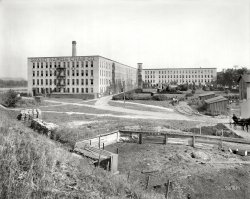
- A Hidden Crime: 1904
- ... Hospital in room 401at 1:26 P.M. on October 31, 1926, Halloween.
The Garrick was at 1120-30 Griswold and stood immediately south ... Posted by Dave - 04/07/2013 - 9:22am -
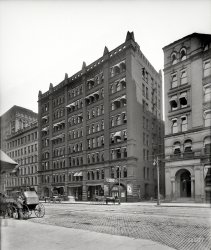
- Winter Sport: 1952
- ...
Just like Saskatchewan but remember to make the halloween costumes large enough to fit over a snow suit eh!
(Kids, Michigan ... Posted by Dave - 08/11/2012 - 8:35pm -
